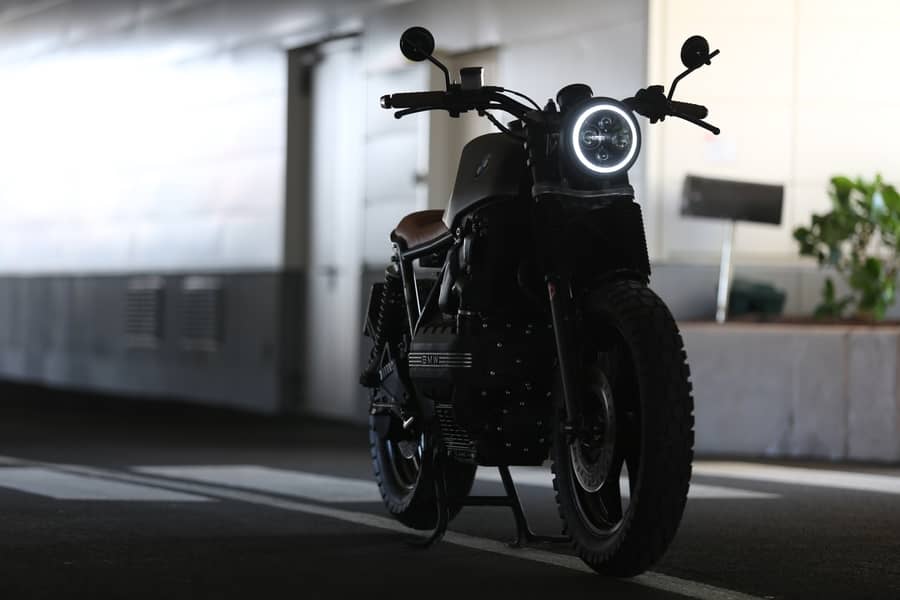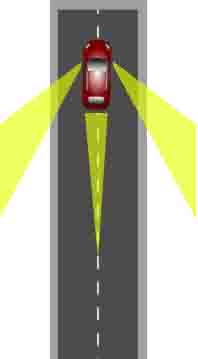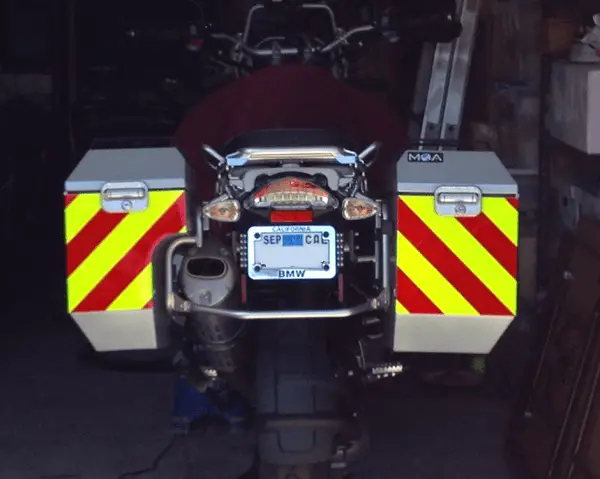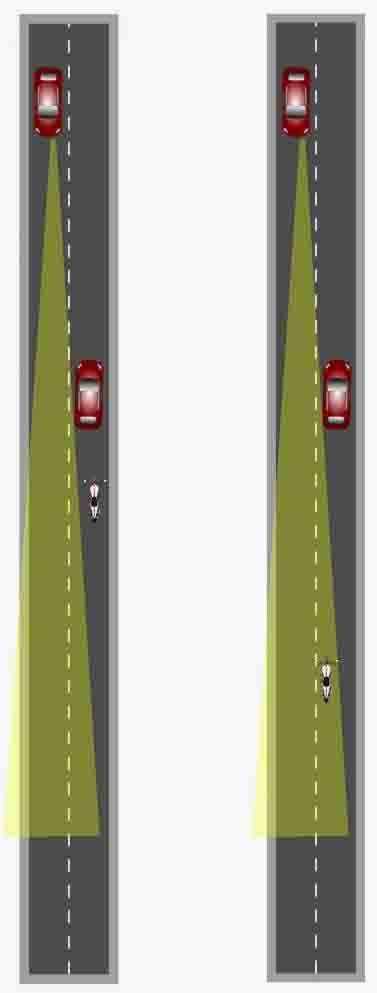As a motorcycle rider, you probably have people around you who tell you that riding a motorcycle is dangerous and they tell you to be careful every single time you leave with your bike. And they are right, in a way.
I mean.. Riding a motorcycle is absolutely more dangerous than driving a car. You don’t have bumpers, a seatbelt or airbags. But we still ride our bikes because we love it, and that’s what matters!
Everybody can get hit by a driver who isn’t paying attention. You can be Valentino Rossi and still get hit by an idiot who pays more attention to his/her phone than to the road.
So that’s why I made a list of 12 tips to be more visible on a motorcycle. The first tips are all about light, followed by tips about your position on the road. Let’s hop into it!
Tip #1: Don’t use high beams during the night
Riding with high beams (or not) is a topic that is always a guarantee for discussion. I’ll share my personal opinion on this. Let me start with high beams during a sunny afternoon.
High beams during summer daytime
I do use my high beams on extremely sunny days. Especially these long straight roads with trees on the side. Why? Because the shadow and bright sunlight confuse other traffic. The bright sunlight in between the trees can take all attention off my (standard) headlight.
I like to think that my high beams stand out in between these strips of sunlight. This is the only situation where I do use my high beams. I don’t use them when it’s not sunny, don’t use them in town and don’t use them on the highway.
High beams during nighttime
Using high beams during nighttime is a whole different type of cookie. My advice is to NOT use high beams during nighttime at all. In fact, you shouldn’t use them during the day eighter if it’s a little bit cloudy and darker outside. All you do is blinding oncoming traffic. They will see a wall of light, but they won’t be able to see YOU!
Another thing to keep in mind is that blinded traffic is not able to properly estimate the width of the gap between you and the side of the road. They won’t see where you are precisely and they won’t be able to see the right side of the road.
There is this saying that you should never look where you DON’T want to go because that will make you go there. The same goes for this wall of light called high beams. Other traffic will look at it, they won’t be able to see what is coming onto them and you might end up being hit by this same traffic.

Tip #2: Add Auxiliary lights to your motorcycle
Auxiliary lights are bright LED lights that you can use during the day. This is a stock feature for newer generation motorcycles. A good example is the BMW GS. It has these beautiful auxiliary lights to be more visible during the day.
Auxiliary lights are available for the front and the back, but I only see a reason to add them to the front of your motorcycle. They add extra visibility to the front and will make you more noticeable for oncoming traffic that wants to turn in front of you.
You taillight should be noticeable anyway. I don’t believe that auxiliary lights are necessary on the back. You should rather look into changing your taillight itself if you think it’s not noticeable enough. Most crash hazards come from the front, so I would worry about that.
Another advantage of (extra) auxiliary lights is the fact that oncoming traffic will be able to determine the distance between them and you better. The auxiliary lights show the width of your motorcycle, putting everything into perspective. Just make sure you use the full width of your motorcycle whiles fitting the auxiliary lights.
Tip #3: Use retro-reflective stickers
This tip will help you to be more visible during nighttime. It’s such a big thing, that I wrote a complete article about it. Check the article “Retro-reflective stickers on a motorcycle” if you want to know more. I’ll summarize it in the next paragraph.
Retro-reflective tape or stickers will make you more visible during the night, because it reflects a vehicles’ headlight, making your motorcycle look bright like a diamond.
You can use reflective stickers on so many parts of your motorcycle. The most popular places are the rims, the back, and sides of your panniers, your helmet, or any other part of your bike that sticks out.
Make sure you buy retro-reflective stickers and not just reflective stickers. Retro-reflective material reflects the light to the direction it was coming from (an oncoming car), whiles reflective material can reflect the light in any direction.
Also, make sure you use the right colors. I wouldn’t use grey or white reflectors on the back of my motorcycle. Use red on the back and white, orange, or yellow on the sides.

Tip #4: Take an advanced driver course
This might be the best tip in this whole list. Being noticed and riding safely in traffic is all about being defensive. Know what the strong and the weak spots of the road are.
An advanced driver course will give you insights in the most common crash scenario’s and will teach you how to behave in traffic. The next tips are actually tips that you’d get in a course like this. It’s all about positioning yourself in traffic.
Tip #5: Keep your distance from cars in front
Keeping your distance is not only a good idea to avoid collisions when the vehicle in front of you comes to a sudden stop. It also helps you to be noticed in traffic.
Driving close behind the vehicle in front of you can make you invisible for oncoming traffic. This increases the chance of getting hit by traffic that wants to turn or that wants to merge into your lane. I made a little drawing to show you the difference.
The situation on the left shows that the oncoming car won’t notice you. It will only see you when it’s super close by. This might be a danger when the car wants to turn left (right in the picture).
The situation on the right side shows you that this is easily avoidable. Just keep some extra distance from the car in front, and oncoming traffic will be able to see you. The same goes for traffic that could come from side streets.
Tip #6: Drive on the left side of the lane
The image above also applies for this tip. Always make sure to drive on the left side of the lane. This will make you visible for oncoming traffic. Just be sure to move over to the right when the oncoming traffic comes close, to keep your distance.
The left picture shows a motorcycle driving on the right side of the lane, which isn’t visible for the car ahead.
The right picture shows a motorcycle driving on the left of the lane, which makes it visible for the oncoming traffic. Just make sure to move over to the right as soon as the oncoming car is getting close, to keep your safe distance. You should always try to keep at least 5 feet (1.5 meters) of distance between you and the oncoming traffic.
Tip #7: Know where the blind spots are

Another very important thing is knowing where the blind spots are. Every vehicle has its blind spots. The bigger the vehicle, the bigger the blind spots!
Make sure you stay out of these blind spots to avoid being hit when the vehicle turns or switches lanes. A common situation is a situation where you ride in the blind spot left or right behind a vehicle. The driver won’t be able to see you in his/her mirrors and you might get hit when they try to switch lanes.
Make sure you eighter overtake the vehicle, or you stay behind the vehicle, avoiding the blind spots. The image on the side shows you where the most common blind spots are. Keep the blind spot in the back in mind when a vehicle doesn’t have a rear window.
Tip #8: Swerve in your lane
This one might sound a little bit odd, but swerving in your lane can make sense.
Motorcycles are narrow and they usually have just one taillight. It’s easy to miss this little tail light, especially in places with heavy traffic. A single motorcycle on a 2-lane road is easy to spot. But a motorcycle in heavy traffic can blend in which all the other lights on the road.
Imagine a big truck in front of you with several rear lights, and maybe some cars beside you. Traffic from behind can easily miss you since your single taillight won’t be noticeable in between all these other lights.
That’s where swerving in your lane comes in. Do you see a car coming up to you from behind? Just swerve in your lane and the driver will notice that the light is moving, and it doesn’t move parallel on the other lights (the rear lights from the big truck).
Swerving in your lane will make your taillight stand out from the rest during nighttime. Just use it when necessary, preferably when a vehicle comes up to you from behind.
Tip #9: Ride in groups
Riding in groups isn’t just fun, it can also increase your safety. Other traffic will notice a bunch of motorcyclists together much earlier on than just one single motorcycle.
Just be aware of the dangers that might come with riding in groups. Don’t try to show off for your buddies, because the positive safety effect of the group will be gone before you know it.
Some tips for riding in groups are:
- Don’t drive in the exact path of the motorcycle in front of you. Drive a little bit left or right of the person in front of you, giving you space to swerve out when they come to a sudden stop.
- Make sure you all get gas at the same time. There is nothing as annoying as a group where somebody else has to get gas every half an hour. Just fill it up altogether and have a great day!
- Use communication systems when possible. These Bluetooth communication systems allow you to speak to each other, making the ride much safer. You can tell the rest where you want to go, tell them if you want to stop and even point out possible dangerous situations.
Riding side by side doesn’t only avoid collisions whiles braking, it also makes the group appear bigger. This will help to be noticed by other drivers much sooner. Together you seem to be one big object, instead of several small objects.
Tip #10: Tap your break(lights)
This tip is quite similar to tip #8, but can only be used while stopping.
Are you stopping for an intersection or a traffic light? Are other drivers coming up to you from behind? That’s the perfect scenario for the “break tap trick”.
Just tap your break, let go, tap the break, let go, etc. Your rear light will be so annoying AND NOTICABLE for traffic behind you. It will also stand out from other taillights since your light is the only one that flashes.
This will tell other drivers that you are not just a 3rd light from the car in front. No, you are a single motorcyclist and they should watch out!
Tip #11: Loud pipes save lives
You’ve probably heared of this saying; “Loud pipes save lives”
It’s funny of course, but it also makes sense in a way. Loud pipes so make people aware that there is a motorcycle closeby. It only helps for short distances, but it can make the difference between being noticed or not.
A great example is Royal Jordanian. Check him out on Youtube if you haven’t heard from him. He rides his bike all across London and revs his engine to be noticed. This works great with pedestrians, but also in rush hour.
Cars in front will hear you coming and loads of people move over to let you filter in between lanes.
The only negative part of this is that most countries have certain rules about how loud your exhaust can be. I personally don’t exceed this allowance since tickets are crazy expensive, but my Akrapovic still makes quite a nice sound. It’s like music to me!
Tip #12: Wear bright colors
This last tip is quite obvious and every single blog will tell you to do this. It can’t miss in this list, but it’s a bit lame cause you probably thought of this yourself already. That’s why I kept it for last.
Your head and body take up a lot of space. In fact, most bikes take up less space than the rider itself. That’s why this is a great opportunity to be noticed!
Everybody knows that bright colors like neon yellow and neon orange mean caution! That’s the reason that you’ll see these colors in signs and clothing of road workers.
A high visibility jacket or helmet will help you to be noticeable. They stand out from the other colors in traffic and allow other drivers to spot you in time. I think that high-vis gear makes a HUGE difference in being noticed.
However, it’s not a guarantee that people will see you! Some riders put on some high-vis gear and thing that everybody will see them from a hundred miles away. I would advise you to not ride in any different manner than you would whiles wearing all black. High visibility gear is no guarantee for safety!
And last but not least; you can also use these high visibility colors on your motorcycle itself. In fact, you can use it in a combination with retro-reflection. I’ll end this article with an example below.


